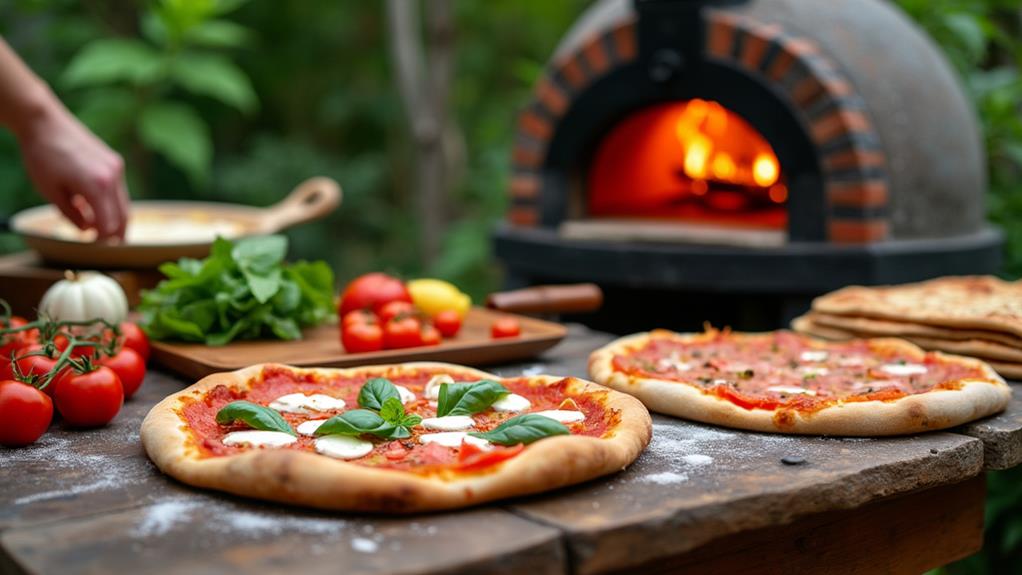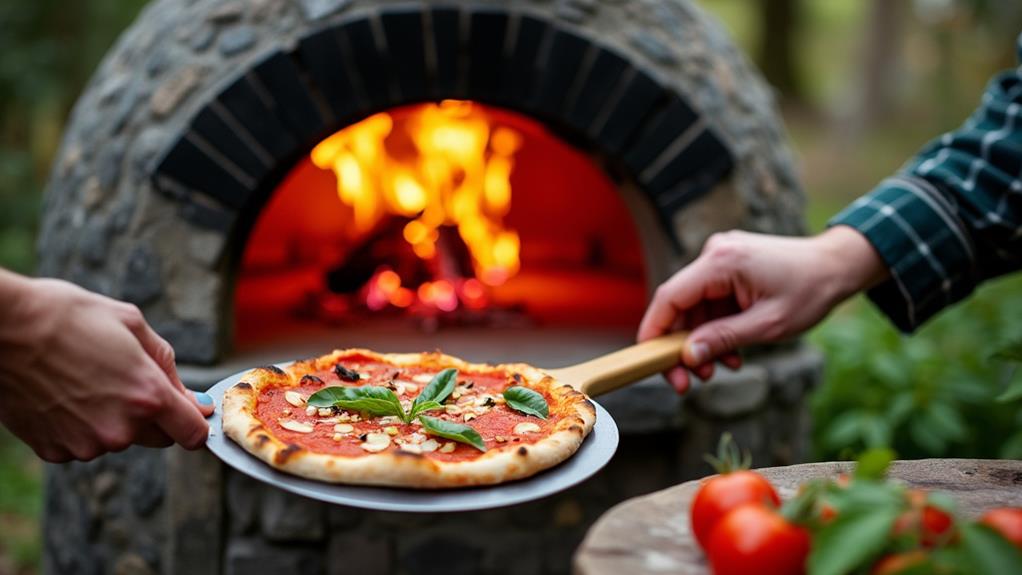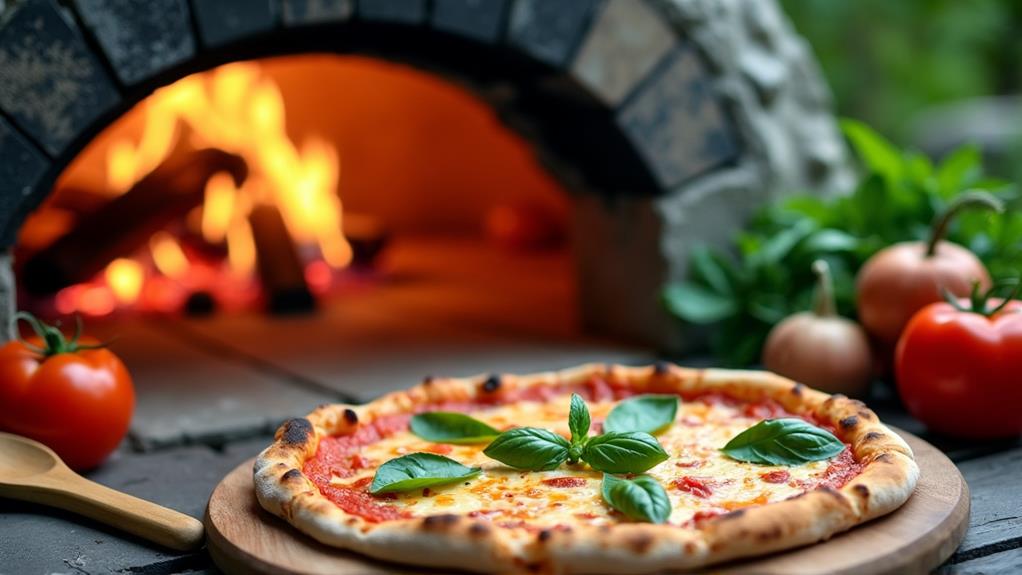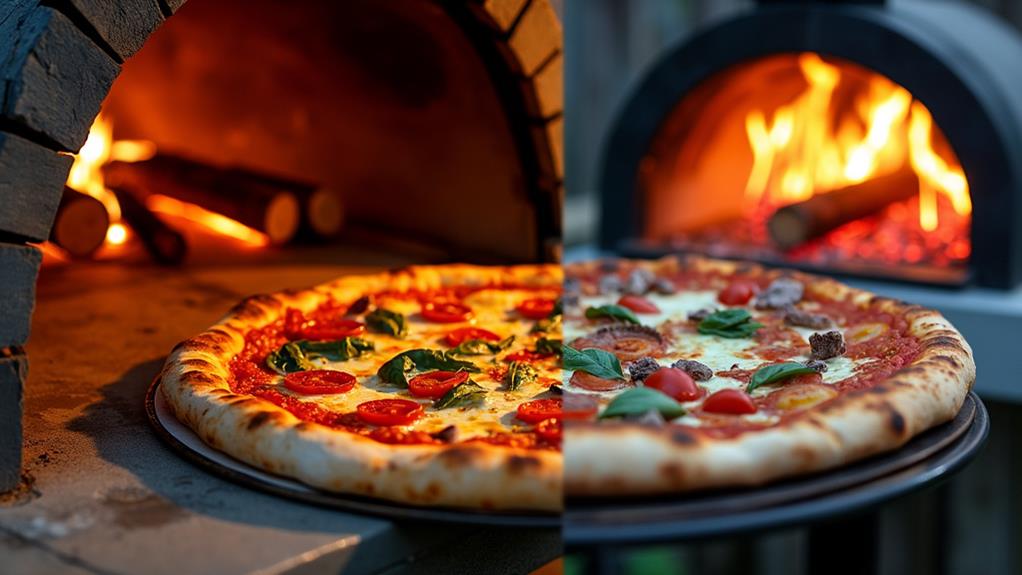Can You Use Charcoal in a Wood-Fired Pizza Oven?
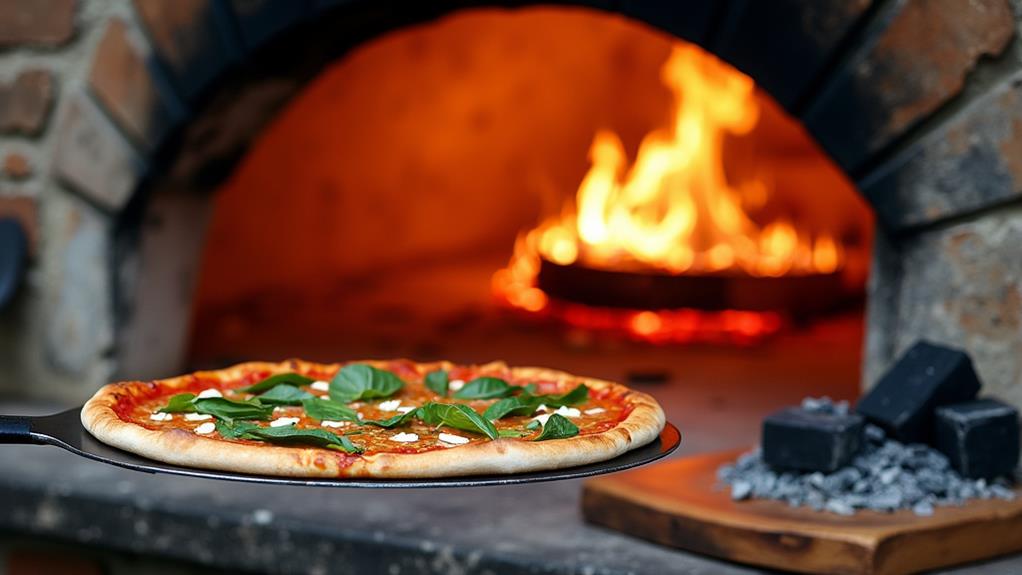
If you're considering using charcoal in your wood-fired pizza oven, it's important to weigh the pros and cons. Charcoal can achieve higher temperatures than wood, which can be beneficial for cooking the perfect pizza crust.
However, it's not just about reaching high temperatures; you must also adhere to specific safety guidelines to mitigate potential risks. So, how can you balance the advantages of using charcoal with the necessary precautions?
Let's explore the best practices, types of charcoal, and maintenance tips to ensure you get the most out of your pizza oven.
Advantages of Charcoal
Using charcoal in your wood-fired pizza oven offers several distinct advantages that can significantly enhance your pizza-making experience.
Firstly, charcoal can quickly reach temperatures of 800 to 1000°F, ideal for achieving that perfect crispy crust. This rapid heating means you won't have to wait long before your oven is ready, allowing you to enjoy your pizza sooner.
One of the main benefits of using charcoal is the consistent heat it provides. This ensures even temperature distribution throughout the cooking process, which is crucial for baking a perfect pizza. No more worrying about hot spots or unevenly cooked slices.
Additionally, charcoal produces less smoke than wood, allowing the natural flavors of your pizza ingredients to shine without being overshadowed by a smoky taste. High-quality lump charcoal also results in a cleaner burn with minimal ash, making cleanup easier.
Lastly, charcoal is generally more affordable than other fuel sources, making it a cost-effective choice for outdoor cooking enthusiasts who want to enjoy wood-fired pizzas without breaking the bank.
Consider making the switch to charcoal and experience the difference it can make.
Types of Charcoal
When selecting charcoal for your wood-fired pizza oven, consider the advantages of lump charcoal, which burns hotter and produces less ash. In contrast, charcoal briquettes provide consistent heat but may alter the flavor due to additives. For an eco-friendly and long-lasting option, coconut shell charcoal offers a unique flavor profile, albeit at a higher cost.
Lump Coal Benefits
Choosing lump coal for your wood-fired pizza oven offers numerous advantages that enhance your cooking experience. Made from hardwoods, lump charcoal burns hotter than briquettes, achieving the high temperatures necessary for perfectly crispy pizza crusts. It produces less ash, simplifying cleanup and improving airflow in your oven.
Lump charcoal ignites quickly, expediting the preheating process and making your cooking sessions more efficient. Free from additives, it ensures a cleaner burn and preserves the natural flavors of your ingredients. Its versatile burning characteristics make it ideal not just for pizza, but also for grilling and roasting.
Here's a quick comparison of lump coal benefits:
| Benefit | Description |
|---|---|
| High Heat | Achieves the temperatures needed for crispy pizza crusts. |
| Less Ash | Simplifies cleanup and enhances airflow. |
| No Additives | Ensures a cleaner burn and preserves natural flavors. |
| Fast Ignition | Speeds up preheating and promotes efficient cooking sessions. |
Briquettes Vs. Lump
Deciding between briquettes and lump charcoal can significantly influence your wood-fired pizza oven experience.
Lump charcoal, made from hardwood, burns hotter and cleaner, reaching temperatures up to 1000°F quickly. This high heat produces less ash and imparts a natural, smoky flavor to your pizza. Additionally, lump charcoal ignites faster, allowing you to start cooking sooner.
Conversely, briquettes offer uniform size and shape, providing consistent and predictable heat, which is ideal for extended cooking sessions. However, they often contain additives that can affect the flavor of your food and may not burn as efficiently as lump charcoal.
Briquettes also take longer to light and stabilize, potentially delaying your cooking process.
While lump charcoal is favored for its natural properties and superior heat, briquettes are more affordable and available in larger quantities. This makes them a convenient option if you're planning a long cooking session or need a budget-friendly choice.
Ultimately, your decision will impact both cooking times and flavor profiles. If you value natural taste and quick ignition, opt for lump charcoal. If consistency and cost are your priorities, briquettes might be your best bet.
Coconut Shell Charcoal
Coconut shell charcoal is an eco-friendly alternative to traditional charcoal, made from the shells of coconuts. It burns hotter than many other charcoals, often reaching temperatures up to 1000°F. This makes it ideal for high-heat cooking, such as baking pizzas in wood-fired ovens. Unlike wood charcoal, coconut shell charcoal produces minimal ash and smoke, ensuring a cleaner cooking experience and preserving the natural flavors of your food.
However, coconut shell charcoal is less common than lump coal or briquettes, making it more expensive and harder to find in some regions. Despite these challenges, it is worth considering if you are committed to sustainability. As a renewable resource, it utilizes a byproduct of coconut processing, contributing positively to environmental efforts.
Here's a quick comparison:
| Feature | Coconut Shell Charcoal | Wood Charcoal |
|---|---|---|
| Heat Output | Up to 1000°F | Varies |
| Ash and Smoke | Minimal | Moderate to High |
| Availability | Less common | Widely available |
Heat Control Techniques
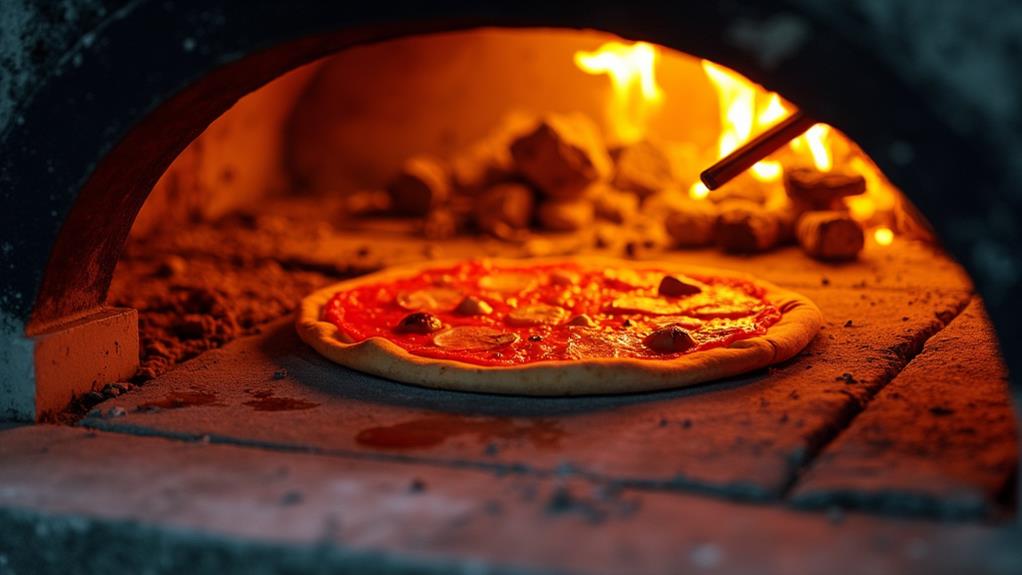
When mastering heat control techniques in a wood-fired pizza oven, it's crucial to monitor the temperature accurately, aiming for a range between 800°F and 1000°F. An oven thermometer is essential for ensuring you achieve the optimal heat for cooking delicious pizzas.
If you decide to use charcoal in your pizza oven, a chimney starter can efficiently ignite it, creating a hot coal bed and raising the oven temperature by 50 to 100 degrees.
To maintain a steady heat, try the "snake method." Arrange briquettes in a continuous ring to allow for a slow, even burn, providing prolonged heat and better temperature control.
Regularly check and adjust the air vents on the oven, as proper vent management controls the burn rate of the charcoal and wood, directly affecting your heat levels.
Additionally, pay attention to how you stack the wood. Maintain spacing between logs around 12-14 inches to allow adequate airflow. This not only aids in efficient heating but also helps maintain a consistent temperature within the oven, ensuring your pizzas cook perfectly every time.
Safety Measures
Ensuring safety when using charcoal in a wood-fired pizza oven is crucial.
First, always ensure proper ventilation to prevent the accumulation of harmful gases and smoke. Adequate ventilation is essential to avoid dangerous situations, so keep your cooking area well-aerated.
Always have a fire extinguisher nearby. Charcoal can generate intense heat and potential flare-ups, so being prepared for emergencies is vital. Keep the fire extinguisher within easy reach to address any unexpected fires quickly.
Consult your oven's manufacturer guidelines regarding charcoal use. Ignoring these guidelines can damage your oven and may void any warranties. It's essential to know what your specific oven can handle concerning charcoal use.
Use only natural, high-quality charcoal free from additives. This minimizes toxic emissions and ensures a cleaner burn, which benefits both your health and the longevity of your oven.
Maintenance Tips
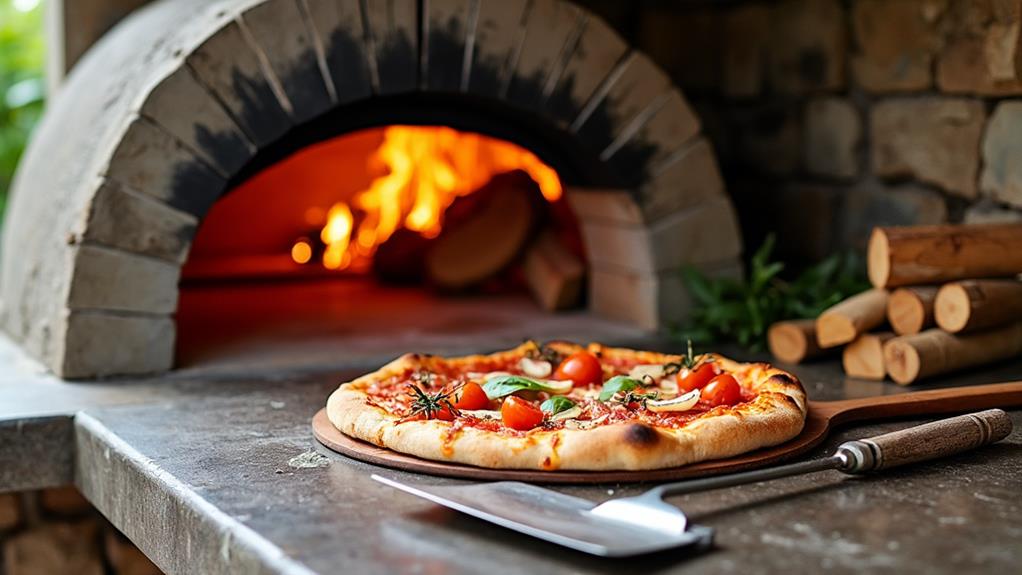
After confirming safety measures are in place, it's essential to focus on maintaining your wood-fired pizza oven for optimal performance.
Regular maintenance not only extends the life of your oven but also ensures that each pizza is perfectly cooked.
First, regularly remove ash from the oven. Ash buildup can obstruct airflow and hinder efficient heat distribution. Keeping the oven clean allows for better temperature control, ensuring your pizzas cook evenly.
Next, inspect and clean the grill grates frequently. Built-up residues can transfer unwanted flavors to your food. A clean grate ensures your pizzas maintain their authentic taste and prevents any burnt residue from affecting future cooks.
Additionally, proper storage of your wood is critical. Store it in a dry place to prevent moisture absorption. Damp wood can be challenging to ignite and burns inefficiently, affecting cooking times and heat levels.
- Feel the satisfaction of a well-maintained oven enhancing your cooking experience.
- Enjoy the peace of mind knowing your oven is clean and running efficiently.
- Relish the authentic flavor of each pizza, free from unwanted residues.
Pizzello Pizza Ovens
Pizzello pizza ovens revolutionize outdoor cooking for enthusiasts and professionals alike. These ovens are meticulously designed to infuse a rich, smoky flavor into your homemade pizzas by utilizing charcoal as a primary fuel source. The Pizzello Forte model, crafted from high-quality stainless steel, excels at maintaining consistent temperatures, making it an excellent choice for both casual and gourmet chefs.
The Gusto model offers unparalleled 4-in-1 versatility, enabling you to grill, bake, roast, and smoke a variety of dishes using charcoal. The Grande model is perfect for large gatherings, featuring dual-layer cooking capabilities and leveraging charcoal for added flavor. For those valuing portability, the Molto model is ideal. It supports both hardwood and charcoal, ensuring efficient heat distribution and ease of transport for your outdoor cooking needs.
Here's a quick comparison of Pizzello pizza ovens:
| Model | Key Feature | Fuel Type |
|---|---|---|
| Forte | Consistent temperature control | Charcoal |
| Gusto | 4-in-1 versatility | Charcoal |
| Grande | Dual-layer cooking | Charcoal |
| Molto | Portability and heat distribution | Hardwood, Charcoal |
With Pizzello, you're not just cooking; you're crafting an exceptional culinary experience.
Manufacturer Guidelines
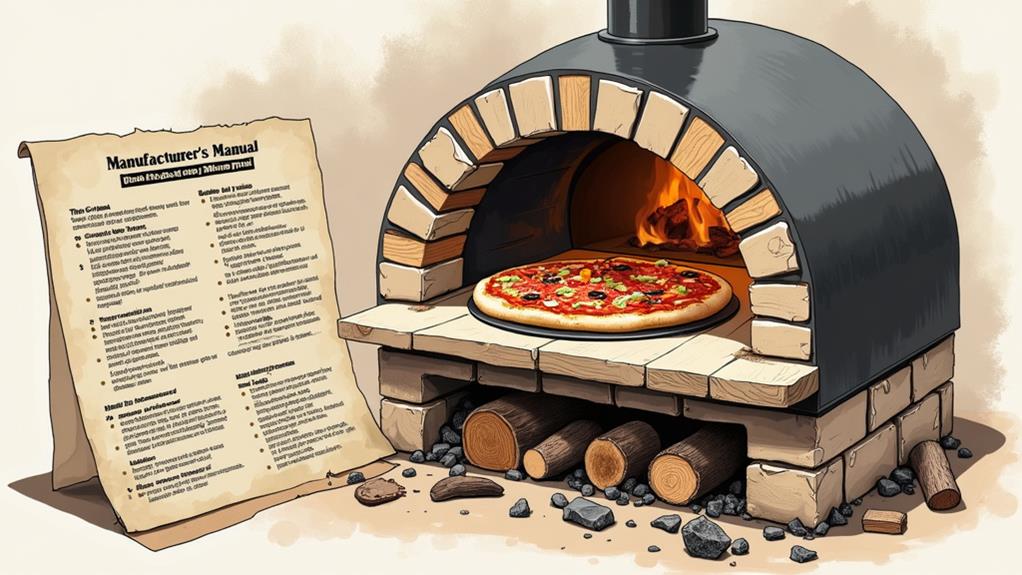
Before using charcoal in your wood-fired pizza oven, it's crucial to review the manufacturer's guidelines to ensure proper and safe usage. These guidelines provide essential information on whether your specific oven model can withstand the intense heat generated by charcoal.
Using charcoal in a pizza oven not designed for it can cause structural cracking due to high temperatures, affecting performance and leading to costly repairs. Additionally, some manufacturers specify that using charcoal may void your warranty if not explicitly approved for their ovens.
Therefore, adhering to the recommended fuel types is vital for maintaining safety and performance standards.
Consider the following points:
- Avoid costly repairs: Structural damage can result in significant financial setbacks.
- Ensure safety: Incorrect fuel use can create safety hazards.
- Protect your warranty: Using unauthorized fuel can void your warranty coverage.
Consulting the manufacturer guidelines ensures you make informed decisions and keeps your pizza oven in top condition.
Always follow the instructions and perform regular maintenance to identify and address any issues early on.
Ideal Foods
Charcoal elevates the flavor profile of various foods, imparting a rich, smoky essence that wood alone can't achieve. When using charcoal in an oven, meats such as lamb and chicken skewers transform into culinary masterpieces. The charcoal enhances their natural taste, adding a smoky depth that's unparalleled.
Whole chickens cooked over charcoal offer numerous possibilities. Whether roasting, grilling, or smoking, charcoal allows for experimentation with different cooking techniques, resulting in flavors and textures that stand out.
Vegetables, too, benefit from charcoal cooking. Bell peppers and zucchini develop a delightful char, enhancing both flavor and visual appeal.
Healthy side dishes like asparagus and corn on the cob significantly improve when cooked over charcoal. The high heat retains their nutrients while intensifying their natural flavors.
Charcoal also excels in wood-fired pizza ovens, enabling the creation of the perfect crust by reaching higher temperatures than traditional wood-firing methods. For those aiming to elevate their culinary creations, using charcoal in an oven is the key to achieving delicious, smoky results.
Community Insights
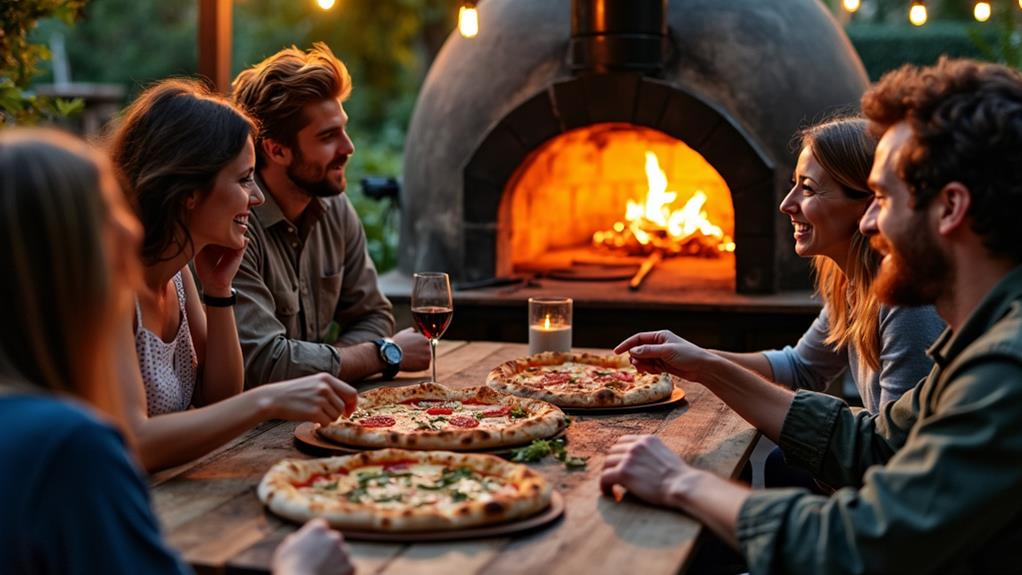
Using charcoal to elevate your dishes opens up a world of culinary possibilities. Community forums reveal a growing interest in incorporating charcoal for quick heating enhancements in wood-fired ovens. Many users report successful experiences with both lump charcoal and briquettes, sharing practical tips like using a chimney starter for efficient ignition and the "snake method" for a prolonged, even burn.
Discussions emphasize the importance of understanding fuel types. Many members clarify that burning lump charcoal correctly usually doesn't lead to operational issues. However, users also caution about potential health risks associated with charcoal emissions, advocating for thorough ventilation and careful monitoring during cooking to mitigate these risks.
The community encourages experimenting with charcoal while adhering to manufacturer guidelines. They highlight the balance between preserving your oven's integrity and exploring diverse cooking techniques.
Here are some sentiments from real users:
- *"The snake method transformed my cooking game!"*
- *"Ventilation is key; don't skip it."*
- *"Charcoal adds a unique flavor you just can't get with wood alone."*
Dive in and discover new flavors!
Conclusion
Using charcoal in a wood-fired pizza oven can enhance your cooking experience with its intense heat and distinctive flavor. It's crucial to follow the manufacturer's guidelines and ensure proper ventilation for safety. Mastering heat control and maintaining the oven regularly will make your cooking process smooth and enjoyable. Whether you're making pizza, bread, or other dishes, you'll appreciate the improved flavors and efficiency that charcoal can offer. Engaging with the community for insights can help you perfect your technique.

